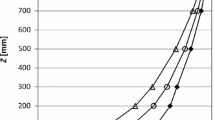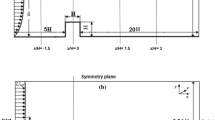Abstract
This paper presents computational simulations of atmospheric dispersion experiments conducted around isolated obstacles in a wind tunnel. The tool used for the simulations is the computational fluid dynamics (CFD) code ADREA-HF, which was especially developed for the calculation of flow and dispersion of positively or negatively buoyant gases in complicated geometries. The wind tunnel experiments simulated involve a cube normal to the flow, a taller rectangular building—comprising of two stacked cubes and a right circular cylinder. Three different gas source locations are examined: two cube heights upwind, at the upwind face and at the downwind face of each obstacle. The experimental data in all cases consist of mean concentrations and concentration fluctuations downwind of the obstacle. In the first part of the study, a computational assessment is performed to examine the influence of factors such as turbulence model, grid resolution, boundary conditions and numerical scheme, on the results of the CFD model in the case of dispersion around an isolated cube. Following this assessment the model parameters are optimized. The model is then used so that computed flow fields and concentration patterns around the three obstacles and for the three different source positions are inter-compared and analysed. Along-wind profiles of computed and measured concentrations and concentration standard deviations have been compared to examine the differences between simulations and wind tunnel experiments. Finally, a statistical performance evaluation of the model is carried out by comparing computed and experimental concentrations and concentration fluctuations. In most cases there is a good level of agreement between calculated and measured quantities, while the model has a general tendency to over-predict concentration fluctuations. In conclusion, the wind tunnel data together with the detailed spatial results that the CFD model produces, give the opportunity to study in detail the flow fields and concentration patterns and to reveal the different behaviours associated with the different obstacle shapes and gas source locations.




















Similar content being viewed by others
References
Chavez M, Hajra B, Stathopoulos T, Bahloul A (2012) Assessment of near-field pollutant dispersion: effect of upstream buildings. J Wind Eng Ind Aerodyn 104–106:509–515
Mavroidis I, Ilia M (2012) Trends of NOx, NO\(_{2}\) and O\(_{3}\) concentrations at three different types of air quality monitoring stations in Athens, Greece. Atmos Environ 63:135–147
Blocken B, Tominaga Y, Stathopoulos T (2013) Editorial: CFD simulation of micro-scale pollutant dispersion in the built environment. Build Environ 64:225–230
Liu XP, Niu JL, Kwok KCS (2011) Analysis of concentration fluctuations in gas dispersion around high-rise building for different wind directions. J Hazard Mater 192:1623–1632
Britter RE, Hanna SR (2003) Flow and dispersion in urban areas. Ann Rev Fluid Mech 35:469–496
Hosker RP Jr. (1984) Flow and diffusion near obstacles. Atmospheric Science And Power Production, (Ed. Randerson D.). Publication DOE/TIC 27601, National Technical Information Service, Springfield, Virginia, USA., 241–326
Mavroidis I, Griffiths RF, Hall DJ (2003) Field and wind tunnel investigations of plume dispersion around single surface obstacles. Atmos Environ 37:2903–2918
Ramponi R, Blocken B (2012) CFD simulation of cross-ventilation flow for different isolated building configurations: validation with wind tunnel measurements and analysis of physical and numerical diffusion effects. J Wind Eng Ind Aerodyn 104–106:408–418
Meroney RN, Leitl BM, Rafailidis S, Schatzmann M (1999) Wind tunnel and numerical modelling of flow and dispersion about several building shapes. J Wind Eng Ind Aerodyn 81:333–345
Mavroidis I, Andronopoulos S, Bartzis JG, Griffiths RF (2007) Atmospheric dispersion in the presence of a three-dimensional cubical obstacle: modelling of mean concentration and concentration fluctuations. Atmos Environ 41:2740–2756
Blocken B, Stathopoulos T, Saathoff P, Wang X (2008) Numerical evaluation of pollutant dispersion in the built environment: comparisons between models and experiments. J Wind Eng Ind Aerodyn 96:1817–1831
Tominaga Y, Stathopoulos T (2009) Numerical simulation of dispersion around an isolated cubic building: comparison of various types of k-\(\varepsilon \) models. Atmos Environ 43:3200–3210
Tominaga Y, Stathopoulos T (2010) Numerical simulation of dispersion around an isolated cubic building: model evaluation of RANS and LES. Build Environ 45:2231–2239
Gousseau P, Blocken B, van Heijst GJF (2011) CFD simulation of pollutant dispersion around isolated buildings: on the role of convective and turbulent mass fluxes in the prediction accuracy. J Hazard Mater 194:422–434
Gousseau P, Blocken B, van Heijst GJF (2012) Large-eddy simulation of pollutant dispersion around a cubical building: analysis of the turbulent mass transport mechanism by unsteady concentration and velocity statistics. Environ Pollut 167:47–57
Said NM, Mhiri H, Bournot H, Le Palec G (2008) Experimental and numerical modelling of the three-dimensional incompressible flow behaviour in the near wake of circular cylinders. J Wind Eng Ind Aerodyn 98:471–502
Andronopoulos S, Mavroidis I, Venetsanos A, Bartzis JG (2011) Modelling of atmospheric flow and dispersion in the wake of a cylindrical obstacle. Int J Environ Pollut 47(1/2/3/4):108–119
Richmond-Bryant J, Eisner AD, Flynn MR (2006) Considerations for modeling particle entrainment into the wake of a circular cylinder. Aerosol Sci Technol 40(1):17–26
Yee E, Kosteniuk PR, Chandler GM, Biltoft CA, Bowers JF (1993) Recurrence statistics of concentration fluctuation in plumes within a near-neutral atmospheric surface layer. Bound Layer Meteorol 66:127–153
Mylne KR, Mason PJ (1991) Concentration fluctuation measurements in a dispersing plume at a range of up to 1000 m. Q J Roy Meteorol Soc 117:177–206
Andronopoulos S, Grigoriadis D, Robins A, Venetsanos A, Rafailidis S, Bartzis JG (2002) Three-dimensional modelling of concentration fluctuations in complicated geometry. Environ Fluid Mech 1:415–440
Schatzmann M, Leitl B (2002) Validation and application of obstacle-resolving urban dispersion models. Atmos Environ 36:4811–4821
Hall DJ, Macdonald R, Walker S, Spanton AM (1996) Measurement of dispersion within simulated urban arrays—a small scale wind tunnel study. BRE Report 178/96, Building Research Establishment, Watford
Mavroidis I (1997) Atmospheric dispersion around buildings. Ph.D. Thesis, UMIST, Manchester
Bartzis JG (1991) ADREA-HF: a three-dimensional finite volume code for vapour cloud dispersion in complex terrain. Report EUR - 13580 EN
Andronopoulos S, Bartzis JG, Würtz J, Asimakopoulos D (1994) Modelling the effects of obstacles on the dispersion of denser-than-air gases. J Hazard Mater 37:327–352
Statharas JC, Venetsanos AG, Bartzis JG, Würtz J, Schmidtchen U (2000) Analysis of data from spilling experiments performed with liquid hydrogen. J Hazard Mater 77:57–75
Neofytou P, Venetsanos AG, Vlachogiannis D, Bartzis JG, Scaperdas A (2006) CFD simulations of the wind environment around an airport terminal building. Environ Model Softw 21:520–524
Neofytou P, Haakana M, Venetsanos A, Kousa A, Bartzis J, Kukkonen J (2008) Computational fluid dynamics modelling of the pollution dispersion and comparison with measurements in a street canyon in Helsinki. Environ Model Assess 13:439–448
Venetsanos A, Papanikolaou E, Bartzis JG (2010) The ADREA-HF CFD code for consequence assessment of hydrogen applications. Int J Hydrog Energy 35:3908–3918
Launder BE, Spalding DB (1974) The numerical computation of turbulent flows. Comput Methods Appl Mech Eng 3:269–289
Yakhot V, Orszag SA (1986) Renormalization group analysis of turbulence I. Basic theory. J Sci Comput 1(1):3–51
Yakhot V, Thangam S, Gatski TB, Orszag SA, Speziale CG (1991) Development of turbulence models for shear flows by a double expansion technique. NASA Contractor Report 187611 - ICASE Report No. 91–65
Bartzis JG (1989) Turbulent diffusion modelling for wind flow and dispersion analysis. Atmos Environ 23:1963–1969
COST 732 (2007) Best practice guideline for the CFD Simulation of flows in the urban environment. Franke J, Hellsten A, Schlünzen H, Carissimo B (Eds), ISBN: 3-00-018312-4
Monin AS, Yaglom AM (1971) Statistical fluid mechanics: mechanics of turbulence, vol 1. The MIT Press, Cambridge
Blocken B, Stathopoulos T, Carmeliet J, Hensen JLM (2011) Application of CFD in building performance simulation for the outdoor environment: an overview. J Build Perform Simul 4:157–184
Leonard BP (1979) A stable and accurate convective modelling procedure based on quadratic upstream interpolation. Comput Methods Appl Mech Eng 19:59–98
Leonard BP (1988) Simple high-accuracy resolution programme for convective modelling of continuities. Int J Numer Methods Fluids 8:1291–1318
Tominaga Y, Stathopoulos T (2013) CFD simulation of near-field pollutant dispersion in the urban environment: a review of current modeling techniques. Atmos Environ 79:716–730
Tominaga Y, Stathopoulos D (2007) Turbulent Schmidt numbers for CFD analysis with various types of flowfield. Atmos Environ 41:8091–8099
Yassin MF, Ohba M, Tanaka H (2008) Experimental study on gaseous diffusion behind an isolated building. Environ Monit Assess 147(1–3):149–158
Lim HC, Thomas TG, Castro IP (2009) Flow around a cube in a turbulent boundary layer: LES and experiment. J Wind Eng Ind Aerodyn 97:96–109
Roshko A (1961) Experiments on the flow past a circular cylinder at very high Reynolds numbers. J Fluid Mech 10:345–356
Donnert GD, Kappler M, Rodi W (2007) Measurement of tracer concentration in the flow around finite-height cylinders. J Turbul 8:N33. doi:10.1080/14685240701429792
Lee T, Lin C-L, Friehe CA (2007) Large-eddy simulation of air flow around a wall-mounted circular cylinder and a tripod tower. J Turbul 8:N29. doi:10.1080/14685240701383122
Wang X, McNamara KF (2006) Evaluation of CFD simulation using RANS turbulence models for building effects on pollutant dispersion. Environ Fluid Mech 6:181–202
Tominaga Y, Stathopoulos T (2011) CFD modeling of pollution dispersion in a street canyon: comparison between LES and RANS. J Wind Eng Ind Aerodyn 99:340–348
Chang JC, Hanna SR (2004) Air quality model performance evaluation. Meteorol Atmos Phys 87:167–196
Chang JC, Hanna SR (2005) Technical Descriptions and User’s Guide for the BOOT Statistical Model Evaluation Software Package, Version 2.0. Downloadable from http://www.harmo.org/Kit/Download/BOOT_UG.pdf
Acknowledgments
The wind tunnel experiments simulated in this paper were conducted with the support of the Atmospheric Dispersion Modelling Group at DSTL Porton Down, under agreement 2044/15/CBDE. The scientific support of Dr. D. Hall and the assistance of Mr. S. Walker of BRE Limited (formerly Building Research Establishment) during the wind tunnel experiments are gratefully acknowledged. The authors would also like to thank the three anonymous referees for their very constructive comments.
Author information
Authors and Affiliations
Corresponding author
Rights and permissions
About this article
Cite this article
Mavroidis, I., Andronopoulos, S., Venetsanos, A. et al. Numerical investigation of concentrations and concentration fluctuations around isolated obstacles of different shapes. Comparison with wind tunnel results. Environ Fluid Mech 15, 999–1034 (2015). https://doi.org/10.1007/s10652-015-9394-3
Received:
Accepted:
Published:
Issue Date:
DOI: https://doi.org/10.1007/s10652-015-9394-3




